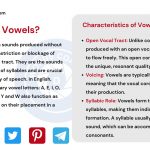Differences Between Vowels and Consonants
Have you ever wondered why some letters seem to sing while others just whisper? The answer lies in the fascinating world of vowels and consonants, the building blocks of spoken language. Today, we’re throwing a language party and dissecting the key differences between these two essential groups!
Consonants and Vowels
Vowels
Imagine yourself belting out your favorite song. When you sing a vowel sound, your mouth is wide open, like an excited party guest. This open air passage allows for smooth and clear sounds to flow freely, creating a resonant quality.
- The Vowel Crew: a, e, i, o, u (and sometimes y)
Consonants
Now, try pronouncing a consonant. Notice how your lips, tongue, or teeth come together to create a bit of a party trick – they partially or completely block the airflow! This obstruction modifies the sound, resulting in consonants with more friction or closure, like whispers or pops.
- The Consonant Posse: b, c, d, f, g, h, j, k, l, m, n, p, q, r, s, t, v, w, x, y (sometimes)
Vowels vs. Consonants
Here’s a quick comparison to show the key differences between these two sound groups:
| Feature | Vowels | Consonants |
|---|---|---|
| Airflow | Free-flowing | Obstructed |
| Mouth Position | Relatively open | Varied (closure with lips, tongue, or teeth) |
| Sound | Clear, resonant | Varied (friction or closure) |
| Function in a Syllable | Nucleus (core sound) | Shape and modify vowel sounds |
The Beautiful Collaboration: Working Together
Vowels and consonants may seem like opposing teams, but they work together like a well-oiled party machine. Vowels provide the main melody, the heart of a syllable, while consonants act as the backup dancers, adding definition and structure.
Imagine the word “cat.” The “a” is the vowel, the clear star of the show. The “c” and “t” are the consonants, shaping the vowel sound and giving the word its unique rhythm.
Fun Facts About Vowels and Consonants
- Not all alphabets have the same number of vowels and consonants! English has 5 vowels and 21 consonants, but Hawaiian has only 13 consonants!
- Double duty letters! The letter “y” can be both a vowel (“fly”) and a consonant (“yellow”).
By understanding the differences between vowels and consonants, you gain a deeper appreciation for the intricate mechanics of language. Now you can analyze words you hear or see, and break them down into their building blocks! Whether you’re a language learner, a writer, or simply a speech enthusiast, this knowledge unlocks the magic of spoken communication. So, keep exploring the fascinating world of sounds, and keep the party going!





